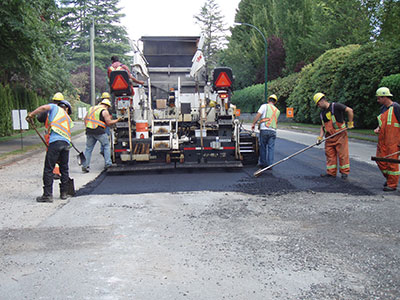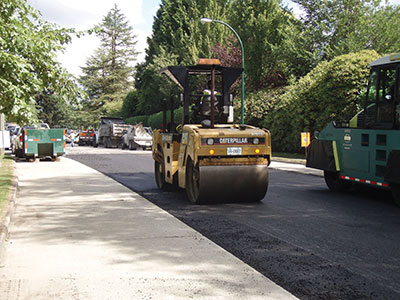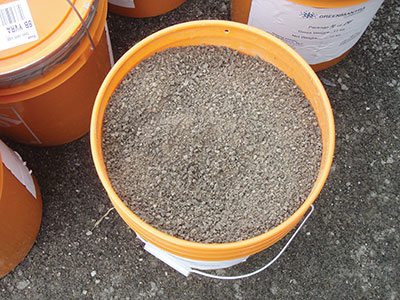
Features
Roads & Paving
Technology
Recycled Road
Vancouver spearheads cutting-edge use of recycled plastic wax in WMA
September 29, 2014 By Treena Hein
In 2012, Vancouver was the first city on the planet to use a wax made
from municipal recycled plastic containers in their warm mix asphalt –
and paving projects using this new mix continue.
In 2012, Vancouver was the first city on the planet to use a wax made from municipal recycled plastic containers in their warm mix asphalt – and paving projects using this new mix continue.
 |
|
| The City of Vancouver uses recycled plastic wax as part of its warm mix asphalt mix for paving municipal roads.
|
Waxes are among the substances (in a group called organic additives) that can be added to warm mix to make it viscous enough for paving, explains Alexander (Sandy) Brown, a member of the Canadian Technical Asphalt Association and technical director at the Ontario Hot Mix Producers Association. “Waxes or other additives allow you to have a viscosity similar to hot mix, but without the high temperature, which takes more energy and involves more fumes. Warm mix is good environmentally.” Waxes typically used to make a warm mix additive are produced during the conversion of coal to liquid fuels (synthetic gasoline and diesel). Other ways to increase the viscosity of warm mix include mechanical foaming, water-mix foaming and using chemical additives.
“I was challenged by City Engineer Peter Judd two to three years ago to come up with a green solution in re-using home-generated recyclables into asphalt while continuing to use RAP, one that didn’t include using glass as an aggregate,” says City of Vancouver Director of Departmental Services Daniel Roberge. He and his team approached GreenMantra of Brantford, Ontario, because of their simple concept of clean plastic conversion to make recycled plastic wax, but also because their methodology could work in warm mix asphalt with high RAP (recycled asphalt pavement) content. Roberge says the process of getting this accomplished was complicated and required that the finished asphalt be easy-to-use and also capable of being re-ground and reused again in the future.
Founded in 2010, GreenMantra produces high-value synthetic hydrocarbons such as waxes and fuels from recycled plastics using specialized catalytic technology. It is the only North American manufacturer of recycled plastic waxes, which are used in a variety of products from asphalt and rubber hoses, to shingles and waterproofing for engineered wood board. “When the City of Vancouver approached us on this endeavour, we found a product we thought would be best,” says Domenic Di Mondo, head of GreenMantra research and development. “Our wax is so far approved in B.C. and Nova Scotia as a warm mix additive, and we have currently applied to get it approved in Ontario and New York State as well. Different municipalities have different evaluation processes, and this takes time.”
 |
|
| The compaction densities are within the Superpave 19mm nominal diameter mixes design parameters according to Roberge.
|
In Vancouver, recycled plastic wax makes up a few per cent of the warm mix. The cost of the wax asphalt is similar to conventional warm mix asphalt and is expected to be as durable. Typically, 20 per cent RAP is used, but it can be up to 25 per cent. After a successful set of trials in 2012, paving projects using the new wax warm mix continued in 2013 and are also occurring this summer. The city continually monitors the sections where it’s been applied, and conducts “Asphalt Pavement Performance Evaluations.” “It’s still somewhat early to get a precise gauge on the durability,” Roberge notes, “but performance and testing indicate results within similar general properties to regular hot mix asphalt with RAP blend.”
Roberge adds that its compaction densities are within their Superpave 19mm nominal diameter mixes design parameters, typically offering 93 per cent to 96 per cent MRD (maximum theoretical relative density). With some extra effort required during compaction, these percentages provide acceptable pavement compaction, he notes, and the range is comparable to conventional mixes.
Percentage TSR (tensile strength ratios) of the wax asphalt range from the low 80s to low 90s, with the unconditioned samples up to 21,000 Newton shear strength. Roberge says this is a positive number overall, adding that their hot mixes with completely new materials will tend to be at a slightly higher ratio.
The wax warm mix scores for VFA (voids filled with asphalt) are in the 65 to 75 per cent range. “It’s too early to tell if that’s a normal range, but we are expecting to be in the 70 per cent range, especially considering a 20 to 25 per cent RAP warm mix asphalt,” Roberge explains.
City of Vancouver paving crews are also blending soya wax (from a local supplier whose name the City did not wish to disclose) and GreenMantra wax to see how this affects the workability of the warm mixes. “The soya wax allows for greater workability for the workers, considering they are raking and shoveling a warm mix asphalt,” Roberge explains. “The viscosity and melt points are lower, therefore allowing the window of workability to be increased with the mix temperature reduced by approximately 70° F compared to hot mix asphalt.” The soya wax also helps soften the RAP asphalt cement. However, the soya wax costs about 70 cents a kilogram more than the recycled plastic wax, Roberge says, and it cannot be produced at present in various viscosities the way recycled plastic wax can.
The City is also working with GreenMantra on creating recycled plastic waxes with lower melt points, focused on boosting workability at lower temperatures. “It has not yet been trialed in asphalt, but we will get there,” Di Mondo says. “To change the properties of the recycled plastic wax is a matter of changing processing conditions.”
How green your asphalt?
Just how “green” wax asphalt is depends on how you look at things, says Brown. “Warm mix is inherently greener than hot mix, but it’s not as green as people would like to think it is,” he comments. “In terms of using wax from recyclable plastics, the whole process would be much more green if the paving was being done in Ontario. Shipping the wax to B.C. adds more greenhouse gasses and energy usage.”
 |
|
| Currently, there isn't enough data to fully understand how well the recycled plastic wax performs in the hot mix.
|
Roberge says it would be great if the wax was being produced locally. “The concept [of this project] is to show that there are positive ways of using green ideas and technologies to improve on current processes, with minimal costs and infrastructure improvements,” he says. “We consider RAP to be an asset that can be reused a number of times, and recycled plastic wax in warm-mix asphalt can help with that goal. Bringing in recycled plastic wax from Ontario is not the right long-term concept, [but] the intent is to share the concept and perhaps others can improve on it.”
“These types of waxes compared to other waxes from coal tar, for example, may make asphalt more sensitive to cold temperatures and fatigue,” Brown notes. “They may become crystalline and brittle. I will be interested to see how the wax asphalt stands up in the long term, remembering that Vancouver doesn’t get as cold as many other areas of Canada.”
Print this page